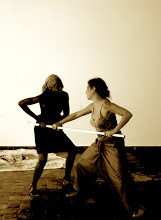The imobility, the breathing, the pause...the moment where the infinit materializes!
It's the only performance we can remember that gives us the power of being both the observer and the observed at the same time in a moment of total PRESENCE. Observing not only ourselves, in a meditative state, but also having an anthropological look over human nature.
"Performance" art in itself was a step ahead to dilute the borders between Life and Art and a means to explore the physical dimension of the body: the implication of the "artist's body" is the only characteristic that doesnt change in the definition of performance art- he is a cultural, social and political agitator!
We Will be Your Mirrors
The distance between the artist and his work of art is undefined. The borders between the spectator and the performer are also diluted.
It's an ephemeral creation, always in transformation, where we assume different archetypes.
It's a form of expression, more than by the action, by the fact that one simply IS!Something internal arises transforming itself in an afirmation of existence...
Feeling our own limits, not only at a physical level but also emotional, mental and even spiritual. Because our eyes can reveal more than the form we take...because we assume the god in us and life itself as a work of art...
Some lose notes about STILLNESS taken from the book "Movement for Actors" (edited by Nicole Potter)....
In medieval church were displayed frozen arrangements, sometimes in procession, of costumed performers reproducing allegorical scenes from the Bible. In Renaissance this was a popular form of entertainment with images of art and literature.
In the XIX century the Pose Plastique, an imitation of classical art, reappeared and was part of cabaret and music hall, specially with Nikita Baliev, a russian producer who develloped the concept of "living dolls". Also Gordon Graig (1872-1966), considered the placement of the actor as a "super-marionette" wich "will not compete with life but rather will go beyond it's restrictions".
For Maeterlinck (1862-1949), one of the first playwrights and theorists of symbolist drama, the silence of a static theater opened a window of spiritual and mysterious forces that control human life and helped to create simple characters of universal significance about human condition. Silence and stillness are a grounding or blanck canvas from wich a production springs and can remain a dynamic and expressive element.
She can be likened to the japanese aesthetic concept of the spaces between the lines of a visual design being as important as the lines themselves-seeing the lines as borders for the spaces.
The image of a stillbody as a mirror to the unconscious connotes a border state of awareness between waking and dream, living and dead, as in a trance state, where the body serves as a kind of mask pointing to possession by multiple inner selves, emotions and extreme forces.
Yeat's says about this inner life:"Who follow the old rule (and) keep their bodies still and their minds awake and clear, dreading especially any confusion between the images of the mind and the objects of sense; they seek to become, as it were, polished mirrors. ("Per Amica Silencia Lunae"in Mythologies, 1917)"
Genevieve Stebbins, on the turn of the XXth century and one of the first theorists of social performance of womanliness, considered this a creative work of intellectual love, a spiritual aspiration toward a superior and definite type of beauty in wich lives and moves a human soul. She used bodily discourse to define a gendered identity that became a performance based assumption that an interior self could and should be expressed and experienced by means of a visual code of womanly poses and movements.
Performance art of the 1960s and 70s emerged from visual art, and so had a natural affinity for stillness. The body again became a direct medium of expression, as conceptual art and happenings put emphasis on the direct experience of time, space, and materials- Gilbert and George ...
The street performers who pose as "living statues" force our curiosity that is piqued to look for signs of life- breathing, a blink, a slight swaying or flinchering-, to give away their artifice. The body is exposed to close scrutiny, and its lack of action, of forward movement, allows the audience to "read" the static image at its own pace and follow its own train of thought.
The fixed image of the body in live performance has a particular resonance since that body occupies the same time and space as the audience and our experience of rythm and tempo are related to pulse and emotion. Our connection to the performer is a kinesthetic one, as we watch a body not unlike our own breathing and held in space, still in a dynamic relationship to gravity in a balance of dynamic forces and heightened awareness of the present moment.
Stillness abstracts physical form, while asking us to reconsider what it is to be alive, sensate and human.
Ilya Prigogine, the physicist known for his work in chaos theory and who finds in art new models for nature, has characterized our era as a convergence of times and spaces in a "time without measure" of stillness: "what we have in mind may be expressed best by a reference to sculture- be it the dancing Shiva or in the miniature temples of Guerrero- in wich there appears very clearly the search for a junction between stillness and motion, time arrested and time passing. It is this confrontation that will give our era its uniqueness."

 Rosário- Ecce Virgo Concipiet em Fátima
Rosário- Ecce Virgo Concipiet em Fátima


